Humbucker and single coil
If we keep it simple, the operation of a humbucker may be quite easy to explain. Let me make an attempt.
Normal guitar element operation
In practice, the operation of an element for the guitar is actually a coil of thin copper wire wrapped around magnets. Vibrating metal (the strings) disturbs the magnetic field, causing a current to be generated. The stream contains information that we amplify when sound comes out of the speakers. For the sound of the guitar from your amplifier, both the magnets and the coil play a role.
Opposite coils
Other sources that can affect the current in the coil are nearby electrical appliances. These sources of interference have an effect on the coil, without the magnets actually playing a role. To make up for such disruption, make a second coil that is wound upside down (exactly the other way around). The interference source then has an effect on the first coil and exactly the opposite effect on the second coil. Actually, the disturbance extinguishes itself. See the red picture below.
In this way you suppress the hum that electrical appliances can give in your environment.
Magnets opposite
But you don't want the moving strings through those reverse coils to suffer as well. However, the strings work with both the magnets and the coil. By placing the magnets with the north pole upwards on one coil and with the south pole upwards on the other coil, the effect of the inverted coil is canceled out again. They actually reinforce each other. See the green picture.
Moving strings
The moving strings have an effect on the combination of the coil and the magnets. Because coil 2 is wound "inverted" but because the magnets are "inverted" there, the wave pattern is reversed twice and is the same as with coil 1. They reinforce each other.
| Coil 1 counterclockwise and magnet north Pole |
+ |
Coil 2 clockwise and magnet south pole |
= |
Result |
 |
|
 |
 |
Disturbing source in the area
Because coil 2 is wound "upside down", the pattern is reversed (peaks and valleys are the other way round with the coils). The result is that they extinguish each other. The magnets do not play a role now.
| Coil 1 counterclockwise |
+ |
Coil 2 clockwise |
= |
Result |
 |
|
 |
|
 |
* The above is a simplified representation and assumes an optimal situation.
Purpose of the humbucker
The purpose of the humbucker was originally to reduce the hum and other interference. The fact that this also gives the sound a different character is sometimes a nice bonus.
Gibson employee "Seth Lover" developed this solution in the 1950s.
This trick can also be performed with a guitar with two single-coil pickups that are used simultaneously. When one of the elements has the direction of the coil and also the magnets reversed, it will give a humbucker effect together with another element. However, the distance between the two coils is greater than with a humbucker element where the coils are next to each other. The effect is therefore less.
Single coil element
|
A disassembled element with a single coil. A coil wound around it, which unfortunately has a break with this copy. The element comes from a 1960s Fender. |
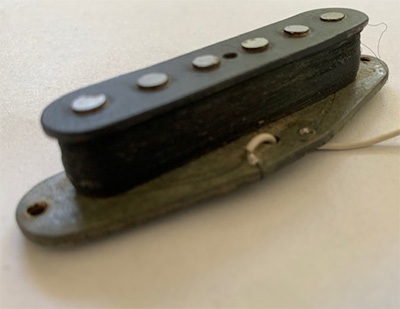 |
Humbucker
|
Often there is a metal or plastic cap that covers the humbucker. You can clearly see the 2 coils where the windings are used in "opposite" direction (arrows). The reverse action of the coils and the inverted magnets thus compensate each other. |
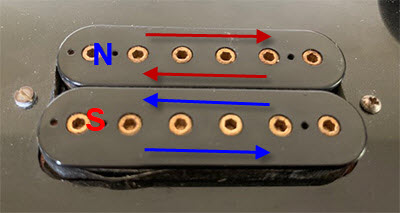 |
Sound
Sound, like smell, is difficult to describe.
With a single-coil pickup, the sound is often indicated as "thin" and "clear." A Fender Telecaster or Stratocaster is a good example.
The sound of a humbucker is also described as "warm", "thick" and "fat". People often immediately think of a "Gibson Les Paul".
Clearly ?
Confusingly, there are also "Les Pauls" with single coil pickups and Telecasters with humbuckers, for example. The width of the element or the double row of magnets often shows what it is all about.
For those who have maintained my explanation to this point, another attempt to create some confusion. The elements on this G&L are humbuckers but with the width of a standard single coil version. The double metal strips per element indicate that they are narrow humbuckers. Two coils and two rows of magnets per element.
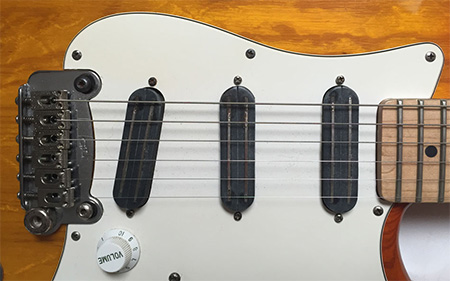
And then a few more. . .
Various guitars with a humbucker have the option of switching off half of the pickup. In that case, in fact, you are simply using a single-coil element with the corresponding character.
And as mentioned earlier, there are also versions in which two single coil elements can play together for humbucker.
Screws instead of magnets
Both with the humbucker and a single coil you will come across variants, where instead of magnets screws can be seen. That way you can set the distance to the parent string. Let's take a closer look at the example from the example below. There are not 2 rows of 6 screws here, but it seems to be 2 x 3.
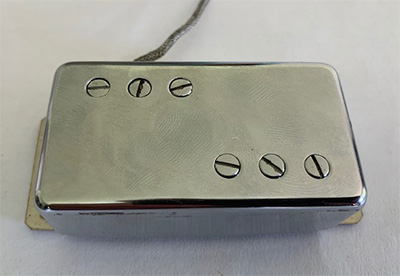
Once opened it turns out to be 2 rows of 6 screws. The bobbins are wrapped around a plastic block. This prevents damage when you turn the screws that have no contact with the copper wire in this way. It is also easy and flexible for the company who produces these elements.
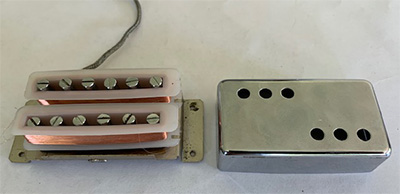
A magnetic field is of course required for operation. In this version, a single magnet has been chosen that faces the top row with the north pole and therefore automatically points to the bottom row with the south pole. The screws take over this magnetism.
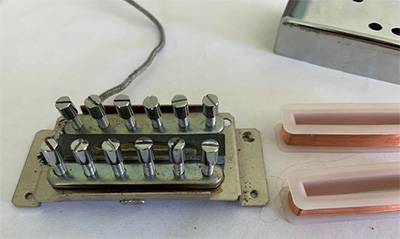
The following photo shows how simple the element actually works. You will encounter the same type of construction with single-coil elements. The manufacturer can then use the same coils, magnets and the plate with the screws. Only another bottom plate and protective cap is needed.

For those who want to know; The example shown (Maxon pickup) is from a 1976 Ibanez.

